An Examination of UAS Incidents: Characteristics and Safety Considerations
Abstract
1. Introduction
- To provide insights into the safety characteristics of reported incidents for Part 107 UAS operations;
- To compare the characteristics of current Part 107 operations with those of recreational UAS operations;
- To identify trends in UAS operations by comparing characteristics of current Part 107 operations with previous studies
- To investigate incident characteristics in different classes of airspace.
2. Literature Review
2.1. UAS Regulatory Development
- Always avoid manned aircraft
- Maintain Visual Line of Sight (VLOS);
- Do not exceed a ground speed of 100 miles per hour (87 knots);
- Fly no higher than 400 feet above ground level unless within 400 feet of a structure;
- Obtain authorization for operations in Class B, C, D, and E airspace;
- Obtain FAA waivers for operations that do not conform to these provisions.
- Access to controlled airspace at or below 400 feet;
- Awareness of safe operational areas;
- Information and updates on temporary flight restrictions (TFRs), the Special Use Airspace (SUA) schedule
- Visibility and transparency regarding locations and times of drone operations.
UAS Safety Training Requirements and Outreach Engagement
2.2. Safety Development in the Crewed Aircraft Sector
- Software (procedures and documentation);
- Hardware (displays and functional systems);
- Environment (social, economic, and natural conditions)
- Liveware (human operators within the system) [41].
2.3. UAS Safety Considerations and Prior Research
3. Methods
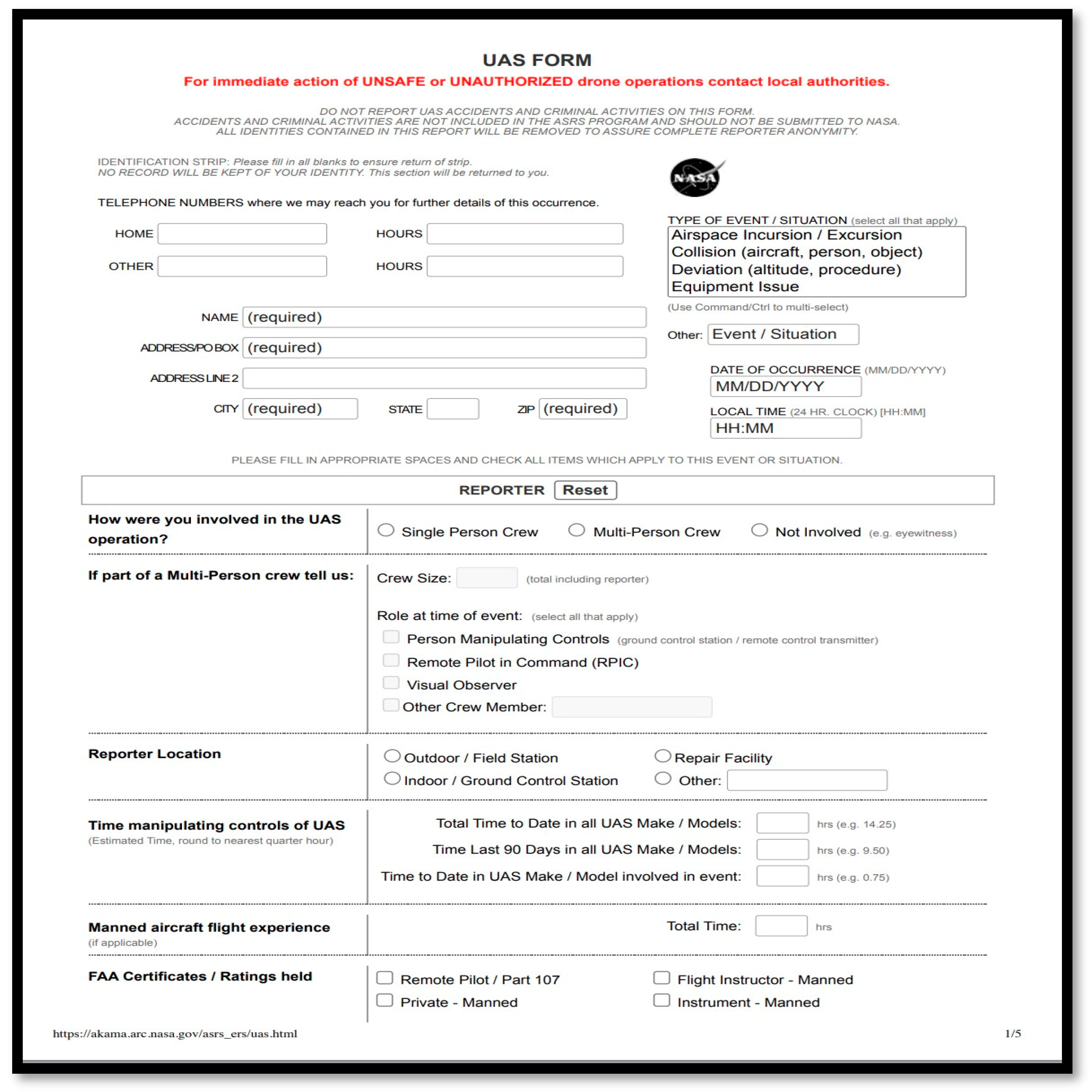
- Reported incident ACN 1721078 contained three keywords: ‘Procedure’, ‘Company Policy’, and ‘Human Factors’. In this case, ‘Procedure’ and ‘Company Policy’ were classified under ‘Policy Issues’, as they reflect inadequacies in the company’s safety procedures, while ‘Human Factors’ was classified under ‘Human Factors’ category.
- Reported incident ACN 1840720 included the keywords ‘Environment—Non-Weather Related’, ‘Human Factors’, ‘Aircraft’, and ‘Software and Automation’. In this case, ‘Environment—Non-Weather Related’ referred to obstruction interference and was classified under ‘Environmental Problems’. ‘Aircraft’ and ‘Software and Automation’ were associated with connection loss and categorized under ‘Equipment Issues’. ‘Human Factors’ reflected the operator’s impaired situational awareness and was directly linked to the ‘Human Factors’ category.
4. Results
4.1. Characteristics of UAS Incidents Under Part 107 Operations
4.2. Compare Part 107 Operations with Recreational Operations
4.3. Comparing Part 107 Operations with Previous Studies
4.3.1. Comparison with Previous Research Regarding Temporal Distribution of UAS Incidents
4.3.2. Comparison with Previous Research Regarding Contributing Factors
4.4. Investigation of Incident Characteristics in Different Classes of Airspace
5. Discussion and Conclusions
Author Contributions
Funding
Data Availability Statement
Acknowledgments
Conflicts of Interest
References
- Hupy, J.; Case, R.; Fu, H.; Klos, D. Unmanned Aerial Systems as a Driving Force in the Digital Information Age. Eng. Technol. Open Access J. 2023, 4, 4. [Google Scholar] [CrossRef]
- Mohsan, S.A.H.; Othman, N.Q.H.; Li, Y.; Alsharif, M.H.; Khan, M.A. Unmanned aerial vehicles (UAVs): Practical aspects, applications, open challenges, security issues, and future trends. Intel. Serv. Robot. 2023, 16, 109–137. [Google Scholar] [CrossRef] [PubMed]
- Grand View Research. Commercial UAV Market—Market Analysis and Forecast. 2023. Available online: https://www.grandviewresearch.com/industry-analysis/commercial-uav-market (accessed on 16 December 2024).
- Wang, C.; Hubbard, S. A Comparison of Airport Risks: Unmanned Aircraft Systems (UAS) Sightings, Wildlife Strikes, and Runway Incursions. J. Aviat. Technol. Eng. 2023, 11, 2. [Google Scholar] [CrossRef]
- International Civil Aviation Organization (ICAO). Safety Management Manual, Doc 9859, 3rd ed.; ICAO: Montreal, QC, Canada, 2013; Available online: https://www.icao.int/SAM/Documents/2017-SSP-GUY/Doc%209859%20SMM%20Third%20edition%20en.pdf- (accessed on 16 December 2024).
- Kovacova, M.; Di Gravio, G.; Patriarca, R. Unmanned Aerial Systems: Status and Forthcoming Challenges for Safety Risk Management. Transp. Res. Procedia 2022, 65, 329–338. [Google Scholar] [CrossRef]
- Skybrary. Heinrich Pyramid. 2022. Available online: https://skybrary.aero/articles/heinrich-pyramid (accessed on 16 December 2024).
- U.S. Congress. FAA Modernization and Reform Act of 2012—H.R. 658, 112th Congress. Washington, DC, USA, 2012. Available online: https://www.congress.gov/bill/112th-congress/house-bill/658 (accessed on 16 December 2024).
- Federal Aviation Administration (FAA). Small Unmanned Aircraft Systems Timeline. 2 January 2022. Available online: https://www.faa.gov/uas/resources/timeline (accessed on 16 December 2024).
- Federal Aviation Administration (FAA), Unmanned Aircraft Systems (UAS). 2022. Available online: https://www.faa.gov/uas (accessed on 16 December 2024).
- U.S. Government Accountability Office (GAO). Unmanned Aircraft Systems: FAA Should Improve Its Approach to Assessing Risks and Enhancing Safety; GAO-23-105189; U.S. Government Accountability Office: Washington, DC, USA, 2023. Available online: https://www.gao.gov/assets/gao-23-105189.pdf (accessed on 16 December 2024).
- Federal Aviation Administration (FAA). UAS Beyond Visual Line of Sight (BVLOS) Aviation Rulemaking Committee Final Report; FAA: Washington, DC, USA, 2022. Available online: https://www.faa.gov/regulations_policies/rulemaking/ (accessed on 16 December 2024).
- Thomas, P.R.; Takahashi, T.T. The Wild West of Aviation: An Overview of Unmanned Aircraft Systems Regulation in the United States. In Proceedings of the AIAA Scitech 2020 Forum, Orlando, FL, USA, 6–10 January 2020; AIAA: Las Vegas, NV, USA, 2020. [Google Scholar] [CrossRef]
- Federal Aviation Administration (FAA). Operations Over People. 10 November 2022. Available online: https://www.faa.gov/uas/commercial_operators/operations_over_people (accessed on 16 December 2024).
- Federal Aviation Administration (FAA). UAS Civil Integration Roadmap, 3rd ed.; FAA: Washington, DC, USA, 2019. Available online: https://www.faa.gov/sites/faa.gov/files/uas/resources/policy_library/2019_UAS_Civil_Integration_Roadmap_third_edition.pdf (accessed on 16 December 2024).
- Federal Aviation Administration (FAA). UAS Data Exchange. 27 March 2024. Available online: https://www.faa.gov/uas/programs_partnerships/data_exchange (accessed on 16 December 2024).
- Federal Aviation Administration (FAA). Remote Identification (Remote ID). 7 August 2024. Available online: https://www.faa.gov/uas/getting_started/remote_id (accessed on 16 December 2024).
- The Drone U. LAANC Authorization. 19 June 2024. Available online: https://www.thedroneu.com/blog/laanc-authorization (accessed on 16 December 2024).
- U.S. Government Accountability Office (GAO). Drones Take Flight, So Do Concerns About Safety. 27 June 2024. Available online: https://www.gao.gov/blog/drones-take-flight-so-do-concerns-about-safety (accessed on 16 December 2024).
- Federal Aviation Administration (FAA). Integration of Civil Unmanned Aircraft Systems (UAS) in the National Airspace System (NAS) Roadmap, 2nd ed.; FAA: Washington, DC, USA, 2018. Available online: https://www.faa.gov/sites/faa.gov/files/uas/resources/policy_library/Second_Edition_Integration_of_Civil_UAS_NAS_Roadmap_July%25202018.pdf (accessed on 16 December 2024).
- Go, E.; Jeon, H.C.; Lee, J.S.; Lim, J.Y. Enhancing Urban Public Safety through UAS Integration: A Comprehensive Hazard Analysis with the STAMP/STPA Framework. Appl. Sci. 2024, 14, 4609. [Google Scholar] [CrossRef]
- Öztekin, A.; Wever, R. Development of a Regulatory Safety Baseline for UAS Sense and Avoid. In Handbook of Unmanned Aerial Vehicles; Springer: Berlin/Heidelberg, Germany, 2014; pp. 1817–1839. [Google Scholar] [CrossRef]
- Hu, P.; Nelson, B.; Nesmith, B.; Williams, K. Annotated Bibliography (1997–2021): Crew and Staffing Requirements of Unmanned Aircraft Systems in Air Carrier Operations; Federal Aviation Administration (FAA): Washington, DC, USA, 2022. Available online: https://www.faa.gov/sites/faa.gov/files/2022-07/Annotated%20Bibliography%20%281997-2021%29-%20Crew%20and%20Staffing%20Requirements%20of%20Unmanned%20Aircrafts%20Systems%20in%20Air%20Carrier%20Operations.pdf (accessed on 16 December 2024).
- U.S. Department of Transportation Office of Inspector General (OIG). FAA UAS Integration Pilot Program Final Report; Report AV2022027; U.S. DOT: Washington, DC, USA, 2022. Available online: https://www.oig.dot.gov/sites/default/files/FAA%20UAS%20Integration%20Pilot%20Program%20Final%20Report_04-27-22.pdf (accessed on 16 December 2024).
- Dao, Q.V.; Martin, L.; Mercer, J.; Wolter, C.; Gomez, A.; Homola, J. Information Displays and Crew Configurations for UTM Operations. In Proceedings of the International Conference on Applied Human Factors and Ergonomics; Chen, J., Ed.; Springer: Cham, Switzerland, 2018; Volume 784, pp. 64–74. [Google Scholar] [CrossRef]
- Federal Aviation Administration (FAA). Knowledge Test Updates for Recreational Flyers. 17 June 2024. Available online: https://www.faa.gov/uas/recreational_flyers/knowledge_test_updates (accessed on 16 December 2024).
- Federal Aviation Administration (FAA). Unmanned Aircraft Systems (UAS): UAS Pilot Testing, Certification and Responsibilities. FAA Air Traffic Publications, Section 5: Washington, DC, USA. 5 September 2024. Available online: https://www.faa.gov/air_traffic/publications/atpubs/aim_html/chap11_section_5.html (accessed on 16 December 2024).
- Federal Aviation Administration (FAA). Drones by the Numbers (as of 10/1/24). 10 October 2024. Available online: https://www.faa.gov/node/54496 (accessed on 16 December 2024).
- International Association of Fire Chiefs (IAFC). UAS Regulatory and Operational Guidance. 2021. Available online: https://www.iafc.org/topics-and-tools/resources/resource/uas-regulatory-ops (accessed on 16 December 2024).
- Federal Aviation Administration (FAA). Certificates of Waiver or Authorization (COA) for UAS. 23 May 2024. Available online: https://www.faa.gov/about/office_org/headquarters_offices/ato/service_units/systemops/aaim/organizations/uas/coa (accessed on 16 December 2024).
- The Droning Company. Does the FAA Part 107 Test Need to Be Updated? 30 May 2024. Available online: https://www.thedroningcompany.com/blog/does-the-faa-part-107-test-need-to-be-updated- (accessed on 16 December 2024).
- Dolgov, I. Establishing Training and Certification Criteria for Visual Observers of Unmanned Aircraft Systems. Safety 2018, 4, 15. [Google Scholar] [CrossRef]
- Koc, K.; Aydin, Y.; Uysal, M. Evaluation of Participant Success in Gamified Drone Training Simulator Using Brain Signals and Key Logs. Brain Sci. 2021, 11, 1024. [Google Scholar] [CrossRef]
- Federal Aviation Administration (FAA). Drone Safety Day. 15 August 2024. Available online: https://www.faa.gov/uas/events/drone_safety_day (accessed on 16 December 2024).
- Federal Aviation Administration (FAA). Join FAA Drone Safety Awareness Week. 27 August 2021. Available online: https://www.faa.gov/newsroom/join-faa-drone-safety-awareness-week (accessed on 16 December 2024).
- Federal Aviation Administration (FAA). Law Enforcement Assistance Program (LEAP). 1 Feburary 2022. Available online: https://www.faa.gov/about/office_org/headquarters_offices/ash/ash_programs/investigations/leap (accessed on 16 December 2024).
- Federal Aviation Administration (FAA). Collegiate Training Initiative for UAS. 13 April 2023. Available online: https://www.faa.gov/uas/educational_users/collegiate_training_initiative (accessed on 16 December 2024).
- Federal Aviation Administration (FAA). Drone Webinars; YouTube Series. Available online: https://www.youtube.com/@FAAnews (accessed on 16 December 2024).
- International Civil Aviation Organization (ICAO). Circular 328: Unmanned Aircraft Systems (UAS); ICAO: Montreal, QC, Canada, 2011; Available online: https://www.icao.int/meetings/uas/documents/circular%20328_en.pdf (accessed on 16 December 2024).
- Wikipedia. 1956 Grand Canyon Mid-Air Collision. 2024. Available online: https://en.wikipedia.org/wiki/1956_Grand_Canyon_mid-air_collision (accessed on 16 December 2024).
- Skybrary. ICAO SHELL Model. 26 June 2022. Available online: https://skybrary.aero/articles/icao-shell-model (accessed on 16 December 2024).
- Skybrary. James Reason HF Model. 2022. Available online: https://skybrary.aero/articles/james-reason-hf-model (accessed on 16 December 2024).
- National Business Aviation Association (NBAA). SMS for UAS; Business Aviation Insider: Washington, DC, USA, 2021; Available online: https://nbaa.org/news/business-aviation-insider/2021-07/sms-for-uas/ (accessed on 16 December 2024).
- Clothier, R.; Walker, R.A. Safety Risk Management of Unmanned Aircraft Systems. In Handbook of Unmanned Aerial Vehicles; Springer: Berlin/Heidelberg, Germany, 2014; pp. 2229–2275. [Google Scholar] [CrossRef]
- Basavaraju, S.; Rangan, V.A.; Rajgopal, S. Unmanned Aerial System (UAS) Hazard Identification, Reliability, Risk Analysis & Range Safety. In Proceedings of the 2019 International Conference on Range Technology (ICORT), Balasore, India, 15–17 February 2019; IEEE: Hyderabad, India, 2019; pp. 1–5. [Google Scholar] [CrossRef]
- Hobbs, A.; Lyall, B. Human Factors Guidelines for Unmanned Aircraft Systems. Ergon. Des. Q. Hum. Factors Appl. 2016, 24, 23–28. [Google Scholar] [CrossRef]
- Neff, P.S. Crew Resource Management for Large Unmanned Aircraft Systems Operations. Int. J. Aviat. Aeronaut. Aerosp. 2019, 6, 1. [Google Scholar] [CrossRef]
- Weldon, W.T.; Hupy, J.P.; Lercel, D.; Gould, K. The Use of Aviation Safety Practices in UAS Operations: A Review. Coll. Aviat. Rev. Int. 2021, 39, 5–8. [Google Scholar] [CrossRef]
- Tvaryanas, A.P.; MacPherson, G. Fatigue in Pilots of Remotely Piloted Aircraft before and after Shift Work Adjustment. Aviat. Space Environ. Med. 2009, 80, 454–461. [Google Scholar] [CrossRef]
- European Union Aviation Safety Agency (EASA). Effectiveness of Flight Time Limitation (FTL); EASA: Cologne, Germany, 2019. Available online: https://www.easa.europa.eu/en/document-library/general-publications/effectiveness-flight-time-limitation-ftl-report (accessed on 16 December 2024).
- Martinetti, A.; Schakel, E.J.; van Dongen, L.A.M. Flying Asset. J. Qual. Maint. Eng. 2018, 24, 152–169. [Google Scholar] [CrossRef]
- Shafiee, M.; Zhou, Z.; Mei, L.; Dinmohammadi, F.; Karama, J.; Flynn, D. Unmanned Aerial Drones for Inspection of Offshore Wind Turbines: A Mission-Critical Failure Analysis. Robotics 2021, 10, 26. [Google Scholar] [CrossRef]
- Reader, T.W.; Noort, M.C.; Shorrock, S.; Kirwan, B. Safety Sans Frontières: An International Safety Culture Model. Risk Anal. 2015, 35, 770–789. [Google Scholar] [CrossRef]
- National Business Aviation Association (NBAA). Developing a UAS Safety Policy. 24 November 2020. Available online: https://nbaa.org/aircraft-operations/emerging-technologies/uas/developing-a-uas-safety-policy/ (accessed on 16 December 2024).
- Pang, B.; Dai, W.; Ra, T.; Low, K.H. A Concept of Airspace Configuration and Operational Rules for UAS in Current Airspace. In Proceedings of the 2020 AIAA/IEEE 39th Digital Avionics Systems Conference (DASC), Virtual, 11–16 October 2020; IEEE: San Antonio, TX, USA, 2020. [Google Scholar] [CrossRef]
- Tvaryanas, A.P.; Thompson, W.T.; Constable, S.H. Human Factors in Remotely Piloted Aircraft Operations: HFACS Analysis of 221 Mishaps over 10 Years. Aviat. Space Environ. Med. 2006, 77, 724–732. [Google Scholar]
- Wild, G.; Gavin, K.; Murray, J.; Silva, J.; Baxter, G. A Post-Accident Analysis of Civil Remotely-Piloted Aircraft System Accidents and Incidents. J. Aerosp. Technol. Manag. 2016, 9, 157–168. [Google Scholar] [CrossRef]
- Huh, S.; Shim, D. A Vision-Based Automatic Landing Method for Fixed-Wing UAVs. J. Intell. Robot. Syst. 2010, 57, 217–231. [Google Scholar] [CrossRef]
- Wang, C.; Hubbard, S.M. Characteristics of Unmanned Aircraft System (UAS) Sightings and Airport Safety. J. Aviat. Technol. Eng. 2021, 10, 16–33. [Google Scholar] [CrossRef]
- Gettinger, D.; Michel, A.H. Drone Sightings and Close Encounters: An Analysis; Center for the Study of the Drone, Bard College: Annandale-On-Hudson, NY, USA, 2015; Available online: https://dronecenter.bard.edu/files/2015/12/12-11-Drone-Sightings-and-Close-Encounters.pdf (accessed on 16 December 2024).
- Pitcher, S.E. Analysis of Unmanned Aircraft Systems Sightings Reports: Determination of Factors Leading to High Sighting Reports. Unmanned Syst. 2021, 10, 205–239. [Google Scholar] [CrossRef]
- NASA. ASRS Analysis of Unmanned Aircraft Systems Sightings Reports. In Proceedings of the Transportation Research Board (TRB) Meeting, Virtual, 20 October 2021; Available online: https://ntrs.nasa.gov/api/citations/20210023200/downloads/ASRS_NAS_TRB_10.20.2021b.pdf (accessed on 16 December 2024).
- NASA Aviation Safety Reporting System. UAS Safety Reporting ASRS 2024. 2024. Available online: https://asrs.arc.nasa.gov/uassafety.html (accessed on 16 December 2024).
- FAA. UAS Incident Reporting Form. 2024. Available online: https://www.faa.gov/forms/ (accessed on 16 December 2023).
- Boyd, D.D. Causes and Risk Factors for Fatal Accidents in Noncommercial Twin Engine Piston General Aviation Aircraft. Accid. Anal. Prev. 2015, 77, 113–119. [Google Scholar] [CrossRef]
- FAA Safety Team. Decision-Making Concepts for UAS Pilots; FAA Safety: Washington, DC, USA, 2024. Available online: https://www.faasafety.gov/gslac/ALC/course_content.aspx?cID=723&sID=1448&preview=true (accessed on 16 December 2024).
- Foster, R.A.; Adjekum, D.K. A Qualitative Review of the Relationship Between Safety Management Systems (SMS) and Safety Culture in Multiple-Collegiate Aviation Programs. Coll. Aviat. Rev. Int. 2022, 40, 67–68. [Google Scholar] [CrossRef]
- Federal Aviation Administration (FAA). Safety Risk Management. 11 September 2024. Available online: https://www.faa.gov/about/initiatives/sms/explained/components#safety_risk_management (accessed on 16 December 2024).
- Liu, Y.; Wang, J.; Chen, Y.; Lv, Z.; Wu, L.; Liu, D.; Song, H. Blockchain-Enabled Secure Authentication for Unmanned Aircraft Systems. arXiv 2021. [Google Scholar] [CrossRef]
- Mavic Pilots Forum. Which App for LAANC. 4 January 2022. Available online: https://mavicpilots.com/threads/which-app-folaanc.120673/#:~:text=Spark%202017%2D%202021%20MA2%202020%20NEO%202024&text=MS%20Coast%20said:,AirData%20or%20AIRMAP?&text=Fly%20low%20and%20slow%20to,the%20buy%20(social%20media) (accessed on 16 December 2024).
- Williams, H. Mitigating Risk of UAS Incursions. 1 July 2019. Available online: https://nbaa.org/aircraft-operations/emerging-technologies/uas/mitigating-risk-uas-incursions/ (accessed on 16 December 2024).
- Federal Aviation Administration (FAA). Award Programs. 16 November 2021. Available online: https://www.faa.gov/about/initiatives/awards (accessed on 16 December 2024).
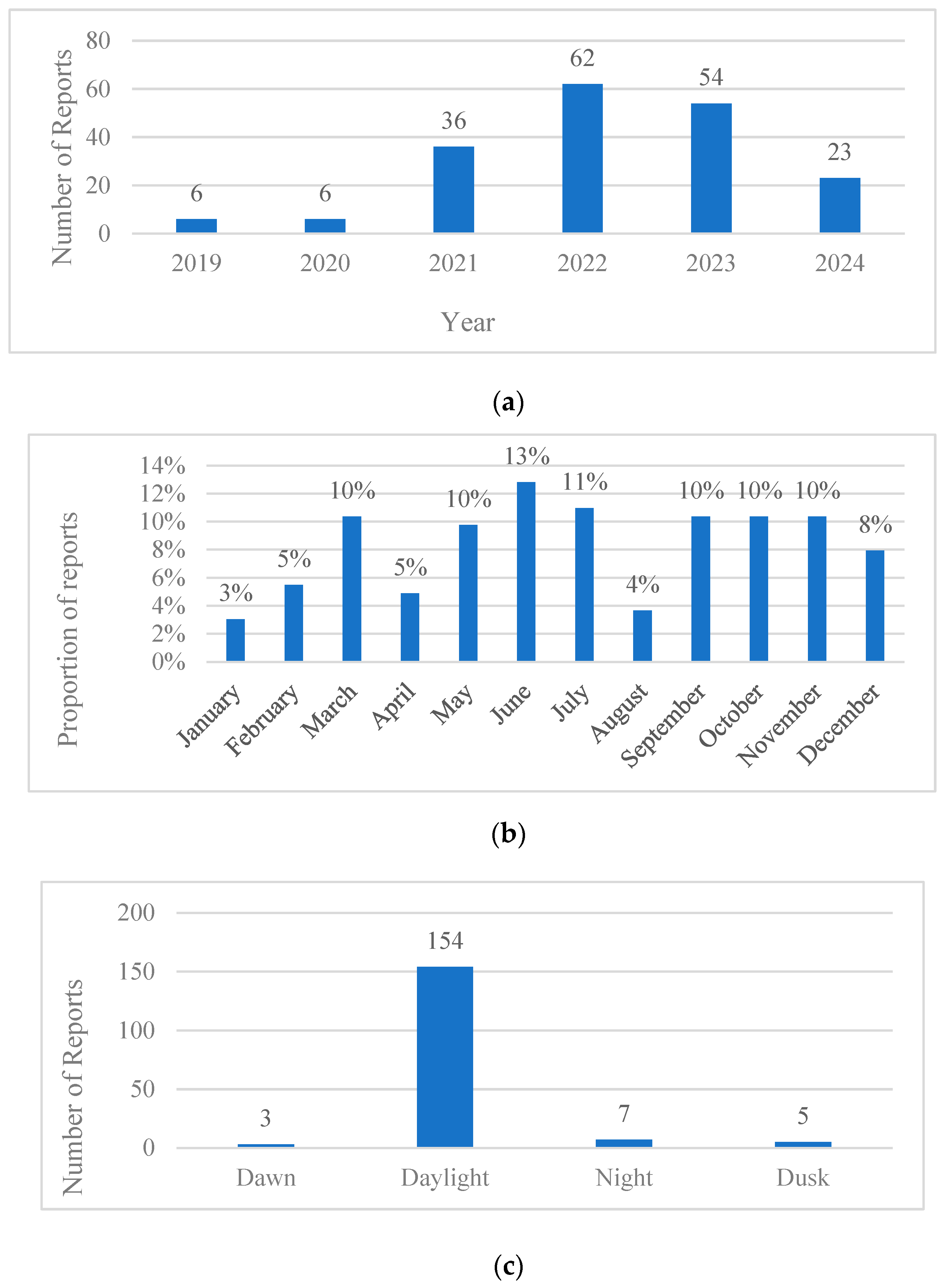
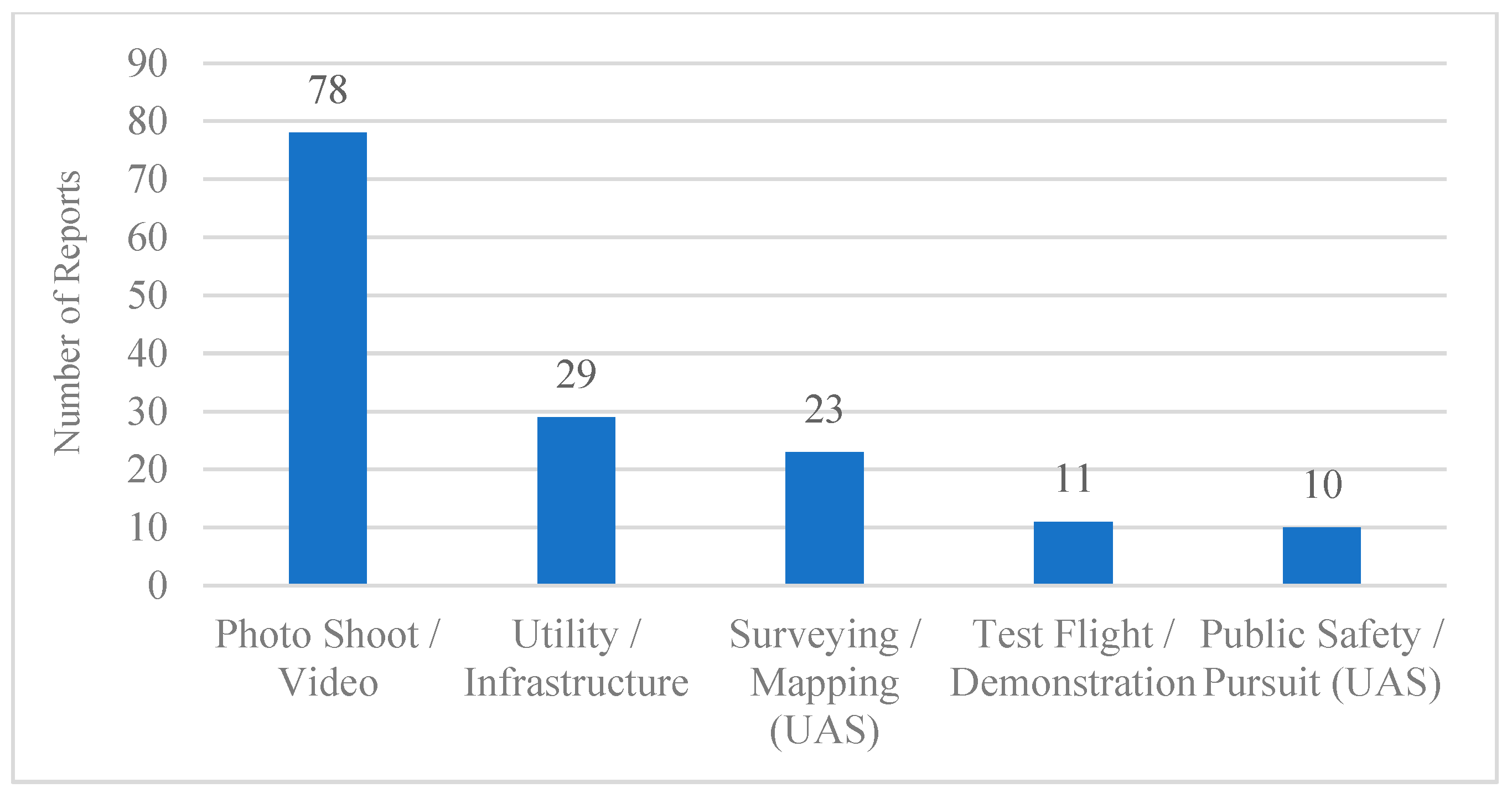
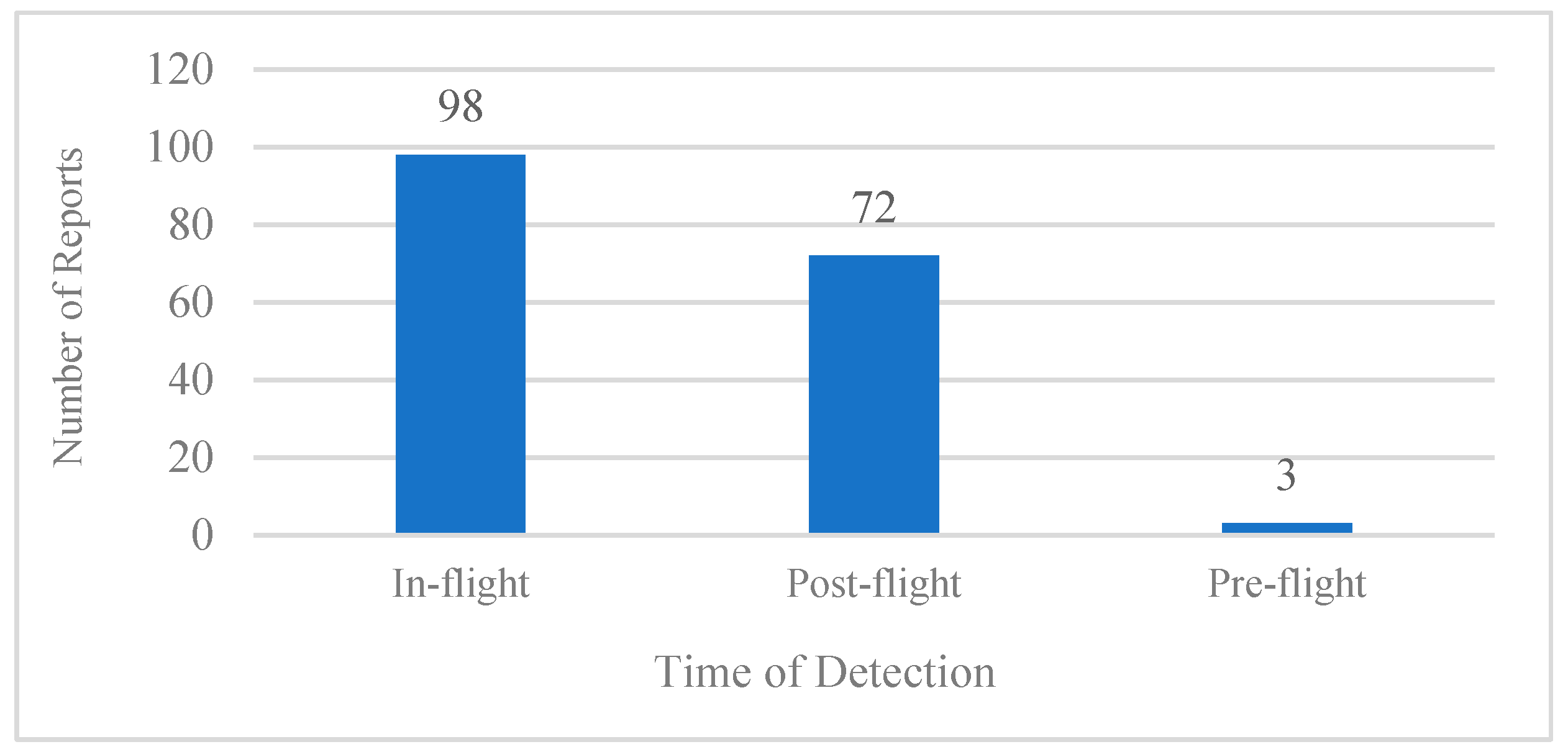


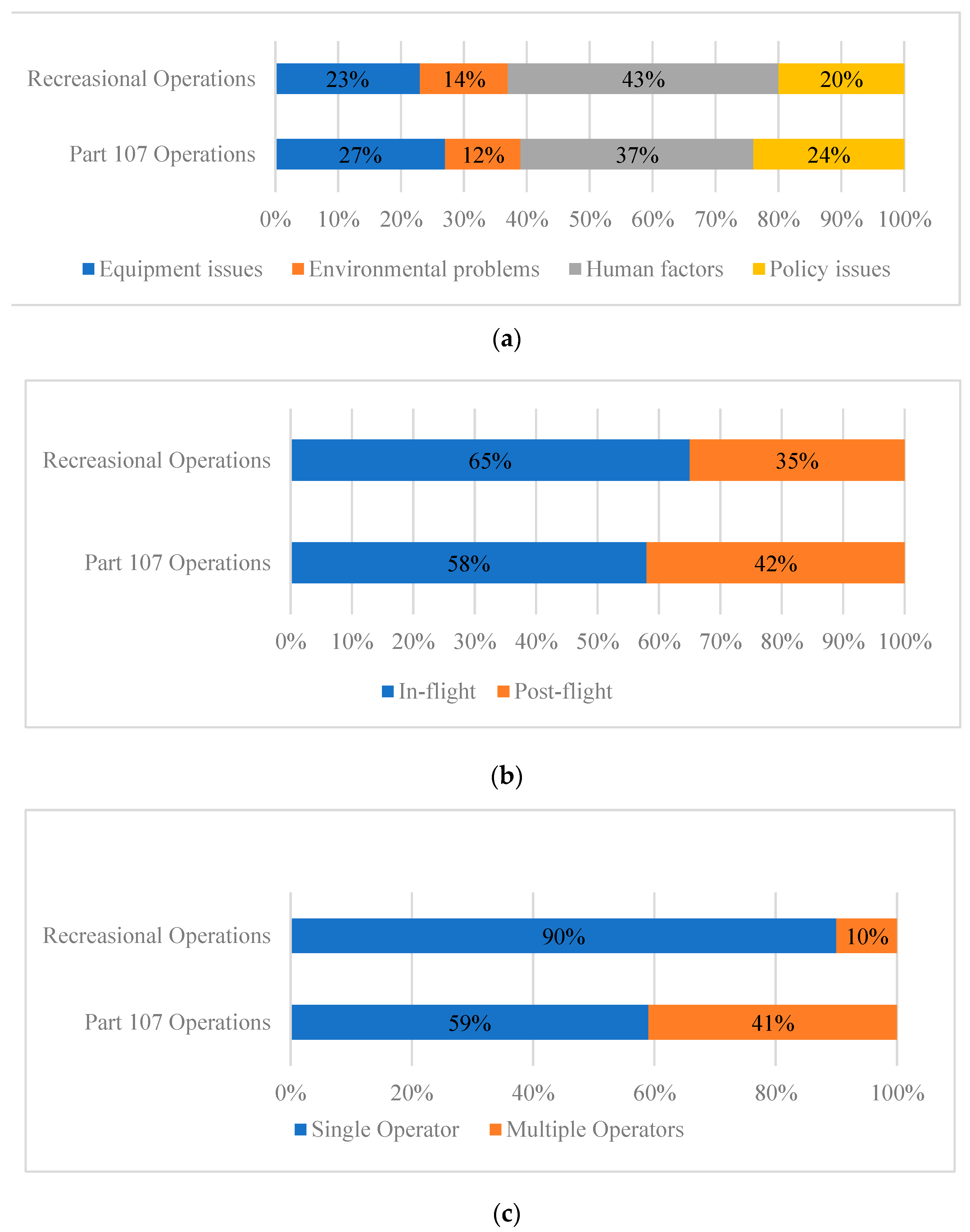

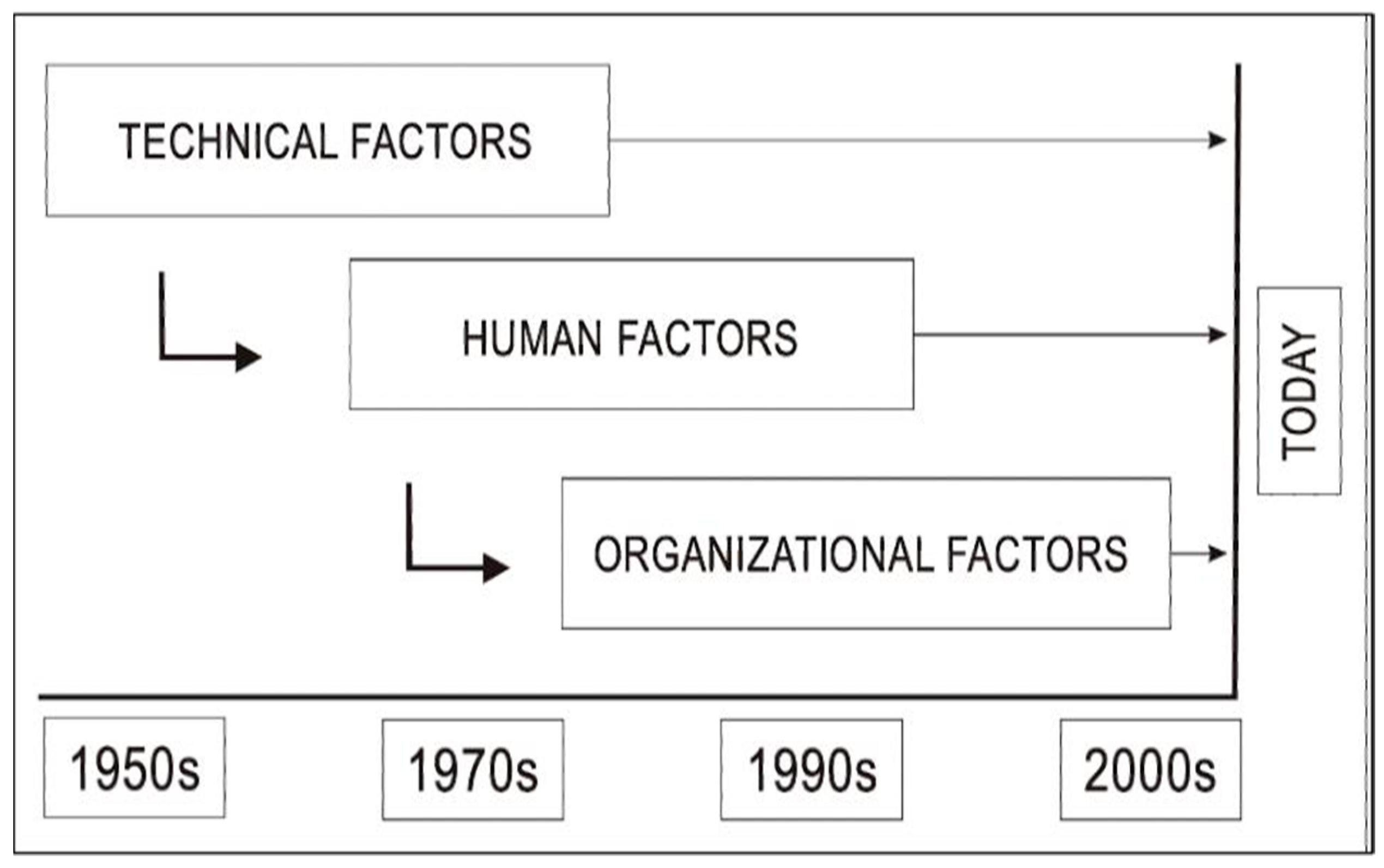
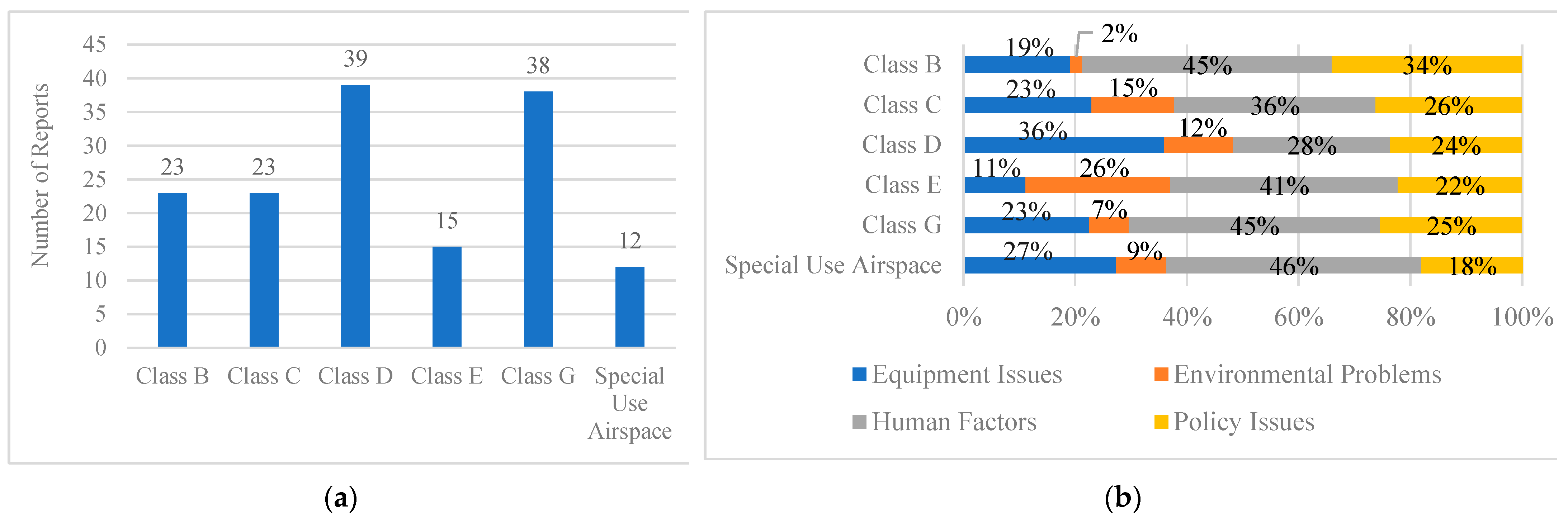
| Variable | Categories |
|---|---|
| Time of Day |
|
| Month |
|
| Operational Mission |
|
| Crew Size |
|
| Airspace |
|
| Time of detection |
|
| Contributing Factors | |
| Human Factors |
|
| Environment |
|
| Equipment Issues |
|
| Policy Issues |
|
| Contributing Factors | Associated Keywords | Associated Issues | Assumptions |
|---|---|---|---|
| Human Factors |
| Relates to operator behavior, decision-making, and mental state, including fatigue, complacency, distractions, impaired situational awareness, and hazardous attitudes. | The keywords ‘Human Factors’ and ‘Staffing’ are always categorized under human factors. |
| Environment |
| Includes weather-related factors (e.g., wind shear, low visibility) and non-weather-related factors (e.g., terrain, obstructions) | The keywords ‘Environmental—Non-Weather Related’ and ‘Weather’ are always categorized under environment. |
| Equipment Issues |
| Relates to hardware and software failures, including component and sensor malfunctions, lost link, and frequency interference. | The keywords ‘Aircraft’, ‘Equipment Tooling’, and ‘Software and Automation’ are always categorized under equipment issues. |
| Policy Issues |
| Relates to organizational safety policy issues, including unclear company policies, deficiencies in safety culture, and deficiencies in operational procedures especially regarding airport and airspace structure. | The keywords ‘Company Policy’, ‘Procedure,’ Manuals’, ‘Airspace Structure,’ and ‘Airport’ are always categorized under policy issues. |
| Nighttime Public Safety Missions—Flights Undertaken with Known Regulation Violations | |||
|---|---|---|---|
| Association Number (ACNs) | Operational Mission | Time of Day | Incident Summary |
| (a) 2062688 | Public Safety/Pursuit | Night | In response to a request from the local fire department to search for a potential accident victim in controlled airspace, the operator attempted to contact ATC but was unable to do so due to off-hours. Prioritizing the urgency of the mission, the operator proceeded with the flight, employing visual observers and safety measures to mitigate risks. |
| (b) 2057627 | Public Safety/Pursuit | Night | In response to a search for a suspect who fled a stolen vehicle, the operator exceeded airspace ceiling limits during a nighttime operation. Safety measures (visual observer and thermal display monitoring) were employed. The violation was acknowledged and attributed to the urgency of the mission rather than intentional noncompliance. |
| Incident Detection during Pre-flight May Reflect “Invulnerability Attitude” | |||
| (c) 1918662 | Photo Shoot/Video | Daytime | The operator operated without obtaining the required LAANC authorization to avoid a lengthy return trip. Citing prior difficulties in requesting approval for the same airport, they chose to fly at a low altitude above the tree line, completing the mission in approximately five minutes. Despite being aware of the regulations, the operator prioritized operational convenience and assumed the operation would not pose significant safety risks. |
| (d) 1853802 | Public Safety/Pursuit | Night | Operating in controlled airspace without obtaining the required LAANC authorization, the operator proceeded with the flights, maintaining visual line of sight (VLOS) and staying below 400 feet AGL while citing adherence to other safety measures. However, prioritizing mission completion over postponing for proper authorization suggests a potential assumption that the operation posed minimal risks. |
| Airspace Classes | Class B, C | Class D, E | Class G | Special Use Airspace |
|---|---|---|---|---|
| Class B, C | N/A | p 1 = 0.14 | p = 0.84 | p = 0.73 |
| Class D, E | p = 0.14 | N/A | p = 0.11 | p = 0.58 |
| Class G | p = 0.84 | p = 0.11 | N/A | p = 0.89 |
| Special Use Airspace | p = 0.73 | p = 0.58 | p = 0.89 | N/A |
| ACN | Reason for Incident Report | Case Summary | Contributing Factors |
|---|---|---|---|
| Class B Airspace | |||
| (a) 1966160 | Near Miss | While near a busy Class B airport, an observer noticed a UAS operation during a runway shift that brought northbound departures closer to the area. Departing airline traffic posed no collision risk, but piston-powered aircraft required greater vigilance. A Cessna on a crosswind departure passed within 100 ft. of the other operator’s UAS. The Remote Pilot in Command (RPIC) of the UAS promptly initiated a descent upon alert but lacked proper situational awareness and familiarity with manned flight procedures. | Env: Obstructed visibility due to high buildings and sunlight HF: Complacency and inadequate training Policy: Lack of radio surveillance or internet-based traffic data |
| (b) 1893543 | Airspace Violation | During a mapping operation near ZZZ airport, a DJI Matrice 210 V2.0 RTK UAS ascended to 297 ft. AGL without obtaining LAANC authorization for a 300 ft. area in Class B airspace. The violation stemmed from the PIC being distracted by a low-battery warning on the primary iPad during pre-flight setup. The oversight was discovered post-flight when notifying ZZZ ATCT. No interference with crewed aircraft operations occurred. | HF: Complacency and pre-flight distractions Policy: Pre-flight checklist gaps |
| Class C Airspace | |||
| (c) 2111236 | Airspace Violation (Exceeding Authorized Altitude) | The crew learned from an oversight during a sUAS flight where the LAANC altitude restriction was not updated after changing the flight area. While the original plan allowed for a 300 ft. AGL flight, the revised plan limited the altitude to 200 ft. the drone was mistakenly set to 279 ft. AGL. This was noticed later when reviewing the airspace and flight data. Additionally, the reporter suggested that simplifying the LAANC interface could help reduce human error by making the authorized information more straightforward. | HF: Impaired situational awareness and inexperienced crew Policy: Pre-flight checklist oversight and complex LAANC authorization system interface |
| (d) 2021216 | Airspace Violation (Exceeding Authorized Altitude) | At approximately XA:29, a pilot climbed to 48.2 m (158 feet) during an operation to capture the exterior of a water tower in Location A. The LAANC approval allowed a maximum altitude of 100 feet. However, the pilot misinterpreted the altitude units, believing the LAANC approval used meters instead of feet, based on the FAA Visualize It website graphic, leading to an unintentional airspace violation. | HF: Unit misinterpretation Policy: Complex LAANC interface design |
| Class D Airspace | |||
| (e) 1884993 | Near Miss | During a dual UAS operation in Class D airspace, a crewed aircraft passed within 60 ft of UAS-1 shortly after takeoff. The drone operator attempted to descend but shifted to an ascent to avoid collision. The crewed aircraft was not detected until it was near the UAS due to environmental noise, distractions from UAS communication, and unfamiliarity with the approach path. | Env: Machinery and road traffic noise HF: Unfamiliarity of crewed aircraft approach path Policy: Inadequate pre-flight preparation |
| (f) 2021216 | Collision | During an authorized UAS flight near a school stadium, the operator heard but could not see a crewed aircraft. In a moment of panic, the operator lost control and ascended the drone, inadvertently exceeding the 400 ft. altitude limit. The crewed aircraft was later spotted approximately one mile away, after which the operator regained control, adjusted the altitude settings, and safely completed the flight.” | HF: Impaired situational awareness Policy: Inadequate separation from ATC |
| Class E Airspace | |||
| (g) 2095036 | Airspace Violation | A drone mission near MVN to collect flood elevation data faced challenges with restricted airspace, fragmented data management, and LAANC approval issues. Despite multiple requests, only limited approvals were granted, complicating planning. Critical information on authorized boundaries was dispersed across devices, while the drone controller’s poor interface and lack of integrated LAANC data impaired situational awareness. ADS-B and CTAF monitoring mitigated traffic risks, but systemic and technological limitations hindered operational safety. | HF: Impaired situational awareness Equip: Poor user interface on drone controllers for programming flight paths Policy: Multiple LAANC rejections without feedback |
| (h) 2042087 | Near Miss | A drone hovering under 50 ft. while filming guests preparing for a hot air balloon ride was involved in a collision with a flying hot air balloon. The flying balloon approached within a few feet of the stationary balloon being filmed, causing the drone to lose control and strike the side of the flying balloon’s basket. | Policy: Inadequate separation from ATC |
| Class G Airspace | |||
| (i) 1943552 | UAS Crash | On a clear, windy day, a drone launched from a park in Location A transitioned to ATTI mode after losing its GPS signal. The operator lost visual tracking and control as the wind pushed the drone eastward. Attempts to activate Return to Home failed due to the GPS loss. The drone was unrecoverable, likely due to battery depletion. | Equip: Loss of GPS signal Env: Moderate winds (15 MPH) |
| (j) 1924069 | UAS Crash | A UAS experienced a flyaway and crashed due to suspected GPS loss while operating in an area frequented by low-altitude manned air traffic. Pilots were instructed to keep the accident secret under threat of job loss. A covert recovery mission retrieved the damaged drone. Concerns were raised about the organization’s immature safety culture. | Equip: Loss of GPS signal Policy: Extremely immature safety culture |
| (k) 1772563 | Waiver Violation | The operator flew multiple UAS under a Part 107 waiver without issuing the required NOTAM 24 h in advance. The operator mistakenly believed that a runway closure NOTAM was sufficient. Upon re-reading the waiver, the operator realized this did not fulfill specific requirements, such as location and altitude details. | HF: Oversight in pre-operation compliance checks Policy: Misinterpretation of waiver provisions |
| Special Use Airspace | |||
| (l) 1629713 | Airspace Violation | The operator inadvertently flew a DJI Inspire 2 into a Temporary Flight Restriction (TFR) zone despite prior awareness and briefing to avoid it. A last-minute change in location and time pressures led to oversight of the TFR. | HF: Impaired situational awareness Policy: Inadequate pre-flight checks |
| (m) 1910447 | Airspace Violation | The operator unintentionally breached a TFR near ZZZ during an active fire. Pre-flight checks relied solely on Sky Vector and Flightradar24, which did not show the TFR. The operator later acknowledged the need for diverse official sources. | HF: Reliance on limited tools Policy: Inadequate pre-flight checks |
| (n) 2051533 | Airspace Violation | A corporate flight was conducted without a licensed operator’s supervision, disregarding warnings about restrictions and licensing. The team exceeded the 400 ft. altitude limit and bypassed the DJI Fly Zone authorization checklist. | Policy: Organizational safety culture deficiency |
| Airspace Class | Number of Incidents | Notable Circumstances |
|---|---|---|
| B | 23 | 18 airspace violations (78%) Three collisions (ground, powerlines, and bird) One near miss with crewed GA aircraft (4%) |
| C | 23 | 21 airspace violations (91%) Four of these exceeded the authorized altitude One lost link |
| D | 39 | 30 airspace violations (77%) Four near misses with crewed aircraft (10%) Two UAS crashes One bird strike risk |
| E | 15 | 14 airspace violations (93%) One collision with balloon (UAS loss of control) (7%) |
| G | 38 | Five exceeded the authorized altitude 20 incident reports with equipment issues (e.g., battery failure, GPS malfunction, lost link) resulted in 10 UAS crashes or fly-aways One operating with an expired license One flying over people One operating without a beacon at night One single operator managing multiple UAS without NOTAM One near miss with crewed aircraft (crop duster) (3%) |
| Special Use | 12 | 12 airspace violations (100%) |
Disclaimer/Publisher’s Note: The statements, opinions and data contained in all publications are solely those of the individual author(s) and contributor(s) and not of MDPI and/or the editor(s). MDPI and/or the editor(s) disclaim responsibility for any injury to people or property resulting from any ideas, methods, instructions or products referred to in the content. |
© 2025 by the authors. Licensee MDPI, Basel, Switzerland. This article is an open access article distributed under the terms and conditions of the Creative Commons Attribution (CC BY) license (https://creativecommons.org/licenses/by/4.0/).
Share and Cite
Sun, J.; Hubbard, S. An Examination of UAS Incidents: Characteristics and Safety Considerations. Drones 2025, 9, 112. https://doi.org/10.3390/drones9020112
Sun J, Hubbard S. An Examination of UAS Incidents: Characteristics and Safety Considerations. Drones. 2025; 9(2):112. https://doi.org/10.3390/drones9020112
Chicago/Turabian StyleSun, Jialong, and Sarah Hubbard. 2025. "An Examination of UAS Incidents: Characteristics and Safety Considerations" Drones 9, no. 2: 112. https://doi.org/10.3390/drones9020112
APA StyleSun, J., & Hubbard, S. (2025). An Examination of UAS Incidents: Characteristics and Safety Considerations. Drones, 9(2), 112. https://doi.org/10.3390/drones9020112





